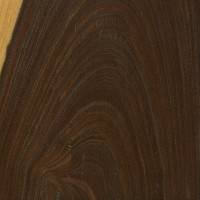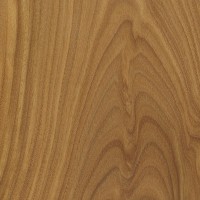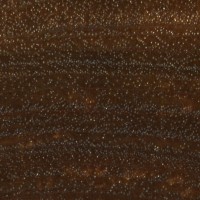by Eric Meier
In the world of wood, Lignum Vitae is the stuff of legends. Among commercially available hardwoods, it is widely regarded as the heaviest and hardest wood in the world. It’s unique olive green color, delicate feathered grain pattern, and other-worldly rot resistance only serves to add to its aura.
Unfortunately, Genuine Lignum Vitae (Guaiacum officinale, G. sanctum) has, like so many other exotic hardwoods, been over-harvested: so much so, that in 2003 it was added to the Convention on International Trade of Endangered Species (CITES) Appendix II, which restricts the wood from traveling or being traded across international borders. As a result, a few closely related species outside of the Guaiacum genus—but still within the Zygophyllaceae family—have been substituted.
Argentine Lignum Vitae (Bulnesia sarmientoi), and Verawood (Bulnesia arborea) are two very closely related wood species that are usually used interchangably with one another. These two species have been used to satisfy the demand of Genuine Lignum Vitae—yet in 2010, Argentine Lignum Vitae (Bulnesia sarmientoi) was also added to the CITES Appendix II, and perhaps it is only a matter of time before all variants and related species of Lignum Vitae are restricted from international trade. Yet not to make the point moot, there are perhaps a number of reasons why one would want to differentiate between Genuine Lignum Vitae and the Argentine variety.
Endgrain: Although the pores are very small and
difficult to make out on both species, examining the endgrain pores is
really one of the easiest and most reliable ways to separate these two
woods. I suggest cleaning up the endgrain and possibly sanding it to a
fine (400+) grit to help get a clear view of the pores and
their arrangement. Using a 10x magnifying lens, you’ll notice two things
about the pores of Genuine Lignum Vitae: they are almost all
exclusively solitary, (that is, none of the pores are bunched together
in groups or pairs), and they are arranged in a somewhat random pattern,
or perhaps slightly diagonally. However, in the pores of Argentine
Lignum Vitae, you’ll notice the pores are frequently arranged in
clusters and radial (vertical) rows. This pore arrangement is a dead
giveaway for Bulnesia spp.
In the world of wood, Lignum Vitae is the stuff of legends. Among commercially available hardwoods, it is widely regarded as the heaviest and hardest wood in the world. It’s unique olive green color, delicate feathered grain pattern, and other-worldly rot resistance only serves to add to its aura.
Unfortunately, Genuine Lignum Vitae (Guaiacum officinale, G. sanctum) has, like so many other exotic hardwoods, been over-harvested: so much so, that in 2003 it was added to the Convention on International Trade of Endangered Species (CITES) Appendix II, which restricts the wood from traveling or being traded across international borders. As a result, a few closely related species outside of the Guaiacum genus—but still within the Zygophyllaceae family—have been substituted.
Argentine Lignum Vitae (Bulnesia sarmientoi), and Verawood (Bulnesia arborea) are two very closely related wood species that are usually used interchangably with one another. These two species have been used to satisfy the demand of Genuine Lignum Vitae—yet in 2010, Argentine Lignum Vitae (Bulnesia sarmientoi) was also added to the CITES Appendix II, and perhaps it is only a matter of time before all variants and related species of Lignum Vitae are restricted from international trade. Yet not to make the point moot, there are perhaps a number of reasons why one would want to differentiate between Genuine Lignum Vitae and the Argentine variety.
Genunine Lignum Vitae |
vs |
Argentine Lignum Vitae |
| Color: Ranges from a light olive green to a darker greenish brown to almost black.* *Despite the great color differences shown in the samples above, both woods have virtually the same color range, and could easily be confused with one another. | Color: Ranges from a light olive or yellowish green to a deep brownish green. *Despite the great color differences shown in the samples above, both woods have virtually the same color range, and could easily be confused with one another. | |
| Average Weight: 84 lbs/ft3 (1,350 kg/m3)* *The two weights are so close, and easily within overlapping range of one another from tree to tree, that weight is not a reliable means to distinguish these two species. | Average Weight: 81 lbs/ft3 (1,300 kg/m3)* *The two weights are so close, and easily within overlapping range of one another from tree to tree, that weight is not a reliable means to distinguish these two species. | |
| Scent: Lignum Vitae has a distinct, perfume-like fragrance that lingers even after it has been machined. (Though typically, the scent seems to be less potent in Genuine Lignum Vitae.) | Scent: Verawood/Argentine Lignum Vitae has a distinct, perfume-like fragrance that lingers even after it has been machined. |
|
|
|




















































































